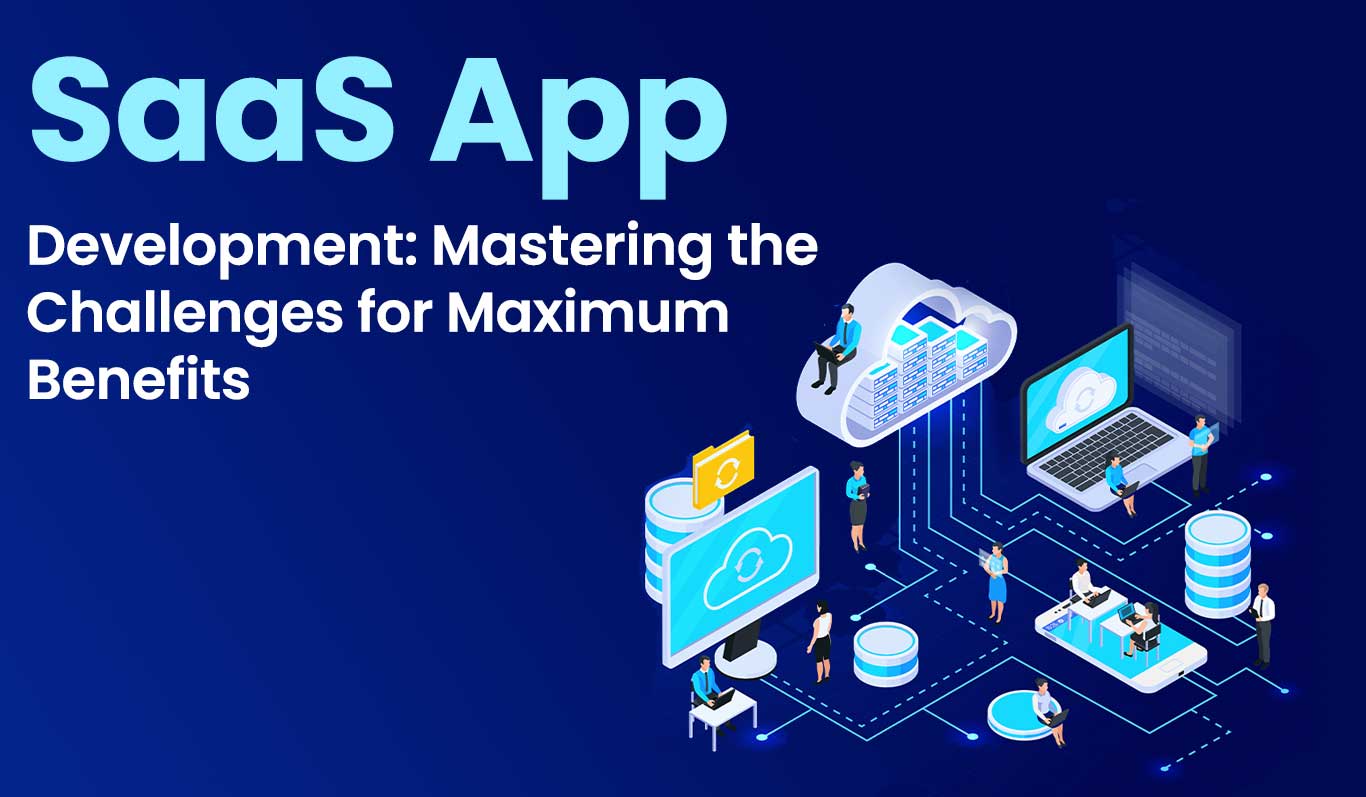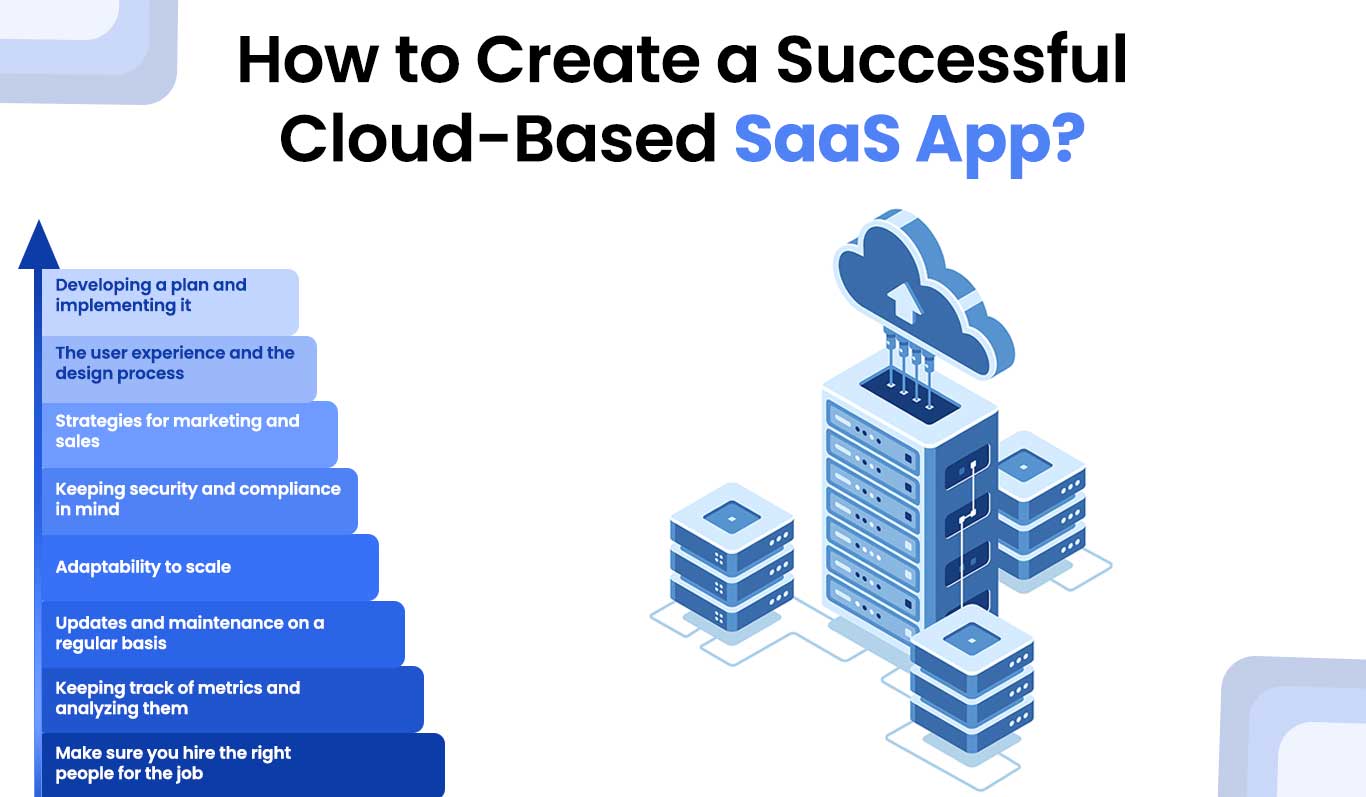SaaS App Development: Mastering the Challenges for Maximum Benefits

Nowadays, there aren't any business areas that don't need SaaS apps. SaaS has become very popular and is helping businesses streamline communication, reduce IT costs, and be more flexible.
A SaaS platform enables businesses to interact better with their audiences, understand their needs more precisely, and act accordingly.
This is the right platform for those interested in leveraging the power of cloud technology. We discuss the advantages, challenges, and other aspects of SaaS application development. Read on to learn more.
What is the SaaS model?

A cloud-based program is what is known as the SaaS model. With SaaS applications, customers can access them through the internet as well as remotely from any device or location.
It is the software provider's responsibility to build, install, configure, and update the application. Rather than purchasing the product outright, SaaS allows consumers renting it on a subscription basis, making monthly or yearly payments on it over time.
Top Benefits of the SaaS Model
SaaS frameworks have a range of advantages for users and software providers, including:
Savings are increased
Traditional on-premise software installations usually require large license fees and other upfront costs. For small or startup businesses with limited budgets, this can be challenging. With SaaS, subscription fees are based on usage, so consumers are able to pay over time and based on usage.
Offers free trials
The SaaS model allows software providers to offer free trials of their products. Usually, customers can test a program for free for a period of seven, fourteen, or thirty days before deciding whether to subscribe.
Boosts cash flow
For both providers and customers, SaaS models can increase cash flow. Cash flow helps companies purchase supplies, pay debts, make investments, and remain in operation overall. The SaaS structure provides business providers with regular, predictable revenue streams. Companies can remain profitable and operational if they have enough profits.
Flexible in its approach
The SaaS model allows users to pay for the service only when they use it, which is an easy way for them to save money. For clients with varying financial situations, custom payment tiers can be designed to meet their needs.
Convenient for the user
There is no doubt that SaaS products can provide convenience to customers because they are managed and developed by providers. Most applications can be accessed by connecting to the web and signing in. Clients no longer need to possess any IT skills because of this instant, easy access.
Employees can become familiar with new software programs quickly and start using them right away. By providing these services, SaaS vendors eliminate technical issues, manage tedious technical tasks, and ensure data security, so clients can focus on more relevant tasks.
Enhances engagement
Businesses can benefit from SaaS business models by increasing their accessibility and affordability, particularly small- and medium-sized businesses.
Most customers want to use cloud-based tools from anywhere. Employees can collaborate and revise in real time with these programs in a remote and independent environment.
Constantly updated
In the SaaS model, software updates are the provider's responsibility, making them easier to implement. Vendors may create new versions of a product once every few weeks or months to keep it relevant to current needs.
Software vendors can continually improve products, take advantage of consumer market trends, and keep customers happy under new market shifts. As soon as bug fixes and new features are available, clients can upgrade with a click.
Enhance security
Data security is the responsibility of the software vendor team. Users can access and store data on internet servers using SaaS models. In the cloud, multifactor authentication and anti-phishing programs are available to clients for high-quality data security.
Examples of Applications that Use the SaaS Model
Here are some examples of products that may use SaaS methodologies:
Applications for messaging: A cloud-based messaging system allows colleagues throughout the world to collaborate effectively. An efficient business operation depends on effective communication between top executives, team leaders, and entry-level employees.
Programs for video conferencing: Business professionals are able to participate in high-quality video conferences, talk face-to-face and share presentations using this software. Updates are constantly made to these products to fix bugs, improve high-speed connectivity, and add new features.
Tools for marketing: Several online marketing tools help companies implement social media, email, and content marketing campaigns. With these systems, businesses can promote products, services and brands in a powerful way, no matter what size they are.
CRM systems: CRM programs help sales and marketing professionals keep track of customer activity, analyze their behavior, and manage accounts. Businesses can enhance products and services by learning what target audiences want and need.
Reliable file storage: For small-to-medium-sized businesses, it can be hard for the IT team to store all the data with limited resources. SaaS businesses offer more quality resources and more storage to organize, back up, and store files.
Recruiting & HR: Employee information, like pay stubs, insurance documents and personal files, is recorded, organized and stored with HR software. Online data access and constant updates are possible with cloud-based software.
Streaming music: Clients can access a library of music from any place, whether they're at work or at home, with a cloud-based music streaming app. Business owners can use these applications to promote music, podcasts, audiobooks and other resources for their employees.
Challenges of Developing a SaaS App
Building a Scalable Infrastructure
SaaS apps are designed to serve a large number of users, so it's important to build an infrastructure that can handle a high volume of traffic and data. This includes designing a robust database, implementing load balancing and caching techniques, and choosing the right hosting provider. Without a scalable infrastructure, a SaaS app may experience slow performance or even crash under heavy load.
Example: A SaaS app for project management experienced slow performance and frequent crashes when it reached 10,000 users. Upon investigation, it was discovered that the app's database was not designed to handle such a high volume of data, leading to slow performance and crashes.
Ensuring Security and Compliance
SaaS apps often handle sensitive user data, so it's crucial to implement robust security measures and comply with relevant regulations. This includes encrypting sensitive data, implementing multi-factor authentication, and regularly running security audits. Failing to comply with regulations such as GDPR, HIPAA, or SOC2 can result in hefty fines, and data breaches can lead to loss of trust from customers.
Example: A SaaS app for healthcare services was found to be non-compliant with HIPAA regulations, resulting in a $1 million fine. The app had not implemented proper security measures to protect patient data, leading to a data breach.
Managing Updates and Maintenance
SaaS apps require ongoing maintenance and updates to ensure they continue to function smoothly and meet user needs. This includes fixing bugs, adding new features, and ensuring compatibility with the latest software and technologies. Failing to keep the app updated can lead to poor performance, security vulnerabilities, and user dissatisfaction.
Example: A SaaS app for accounting had not been updated in over a year, leading to compatibility issues with the latest versions of popular browsers. As a result, many users experienced difficulty using the app, leading to a loss of customers.
Acquiring and Retaining Customers
SaaS apps rely on a steady stream of customers to generate revenue, so it's important to have a solid marketing and sales strategy in place. This includes targeting the right audience, offering a free trial or freemium model, and providing excellent customer support. Without a clear strategy for acquiring and retaining customers, a SaaS app may struggle to generate revenue and become unprofitable.
Example: A SaaS app for graphic design was not effectively targeting the right audience and struggled to acquire new customers. As a result, the app was not generating enough revenue to cover its expenses and had to shut down after a year.
What are the Benefits of Developing a Saas App for a Business?
Recurring Revenue Model: One of the biggest benefits of developing a SaaS app is the recurring revenue model. Instead of making a one-time sale, SaaS apps generate revenue through subscription fees, which can provide a steady stream of income over time. This can also help to predict and plan for future revenue, allowing for better forecasting and budgeting.
Example: A SaaS app for project management charges a monthly subscription fee of $10 per user. With 10,000 users, the app generates $120,000 in monthly recurring revenue.
Scalability: SaaS apps can be easily scaled up to meet the needs of a growing user base. This allows for a more efficient use of resources and can save on costs in the long run. Additionally, this allows businesses to grow at a faster pace, taking advantage of economies of scale.
Example: A SaaS app for customer relationship management started with only a few thousand users but grew to over a million in just a few years, thanks to its ability to scale.
Low Cost: SaaS apps do not require large upfront investments in hardware and software, making them a cost-effective option for many businesses. Additionally, the subscription-based model can also help to reduce costs over time, as the costs are spread out over the life of the subscription.
Example: A SaaS app for inventory management costs $50 per month per user, compared to a traditional software solution that would cost $500 to purchase and an additional $50 per month for maintenance.
Flexibility: SaaS apps can be accessed from anywhere with an internet connection, making them a flexible option for both businesses and users. This allows for remote work and collaboration, and also allows businesses to reach a global audience.
Example: A SaaS app for project management is used by teams in different locations, allowing for seamless collaboration and communication, regardless of where team members are located.
Ease of use: SaaS apps are designed to be easy to use and accessible to a wide range of users, making them a popular choice for businesses of all sizes. With a user-friendly interface and simple navigation, employees can quickly learn to use the app and start working with it efficiently.
Example: A SaaS app for accounting has a simple and intuitive interface, allowing even non-accountants to easily navigate and understand the app. This led to a high adoption rate among employees, resulting in increased productivity and efficiency.
How to Create a Successful Cloud-Based SaaS App?

Developing a plan and implementing it
Before developing a SaaS app, it's important to have a clear plan in place. This includes identifying the target market, understanding user needs, and determining the unique value proposition of the app. It's also important to research the competition and understand current market trends. Once a plan is in place, it's crucial to execute it effectively, with a clear development timeline and budget.
The user experience and the design process
A SaaS app should be designed with the user in mind. This includes creating a user-friendly interface and simple navigation, making sure the app is accessible on multiple devices and platforms, and providing thorough documentation and tutorials. Additionally, it's important to conduct user testing to gather feedback and make adjustments as necessary.
Strategies for marketing and sales
A SaaS app relies on a steady stream of customers to generate revenue, so it's important to have a solid marketing and sales strategy in place. This includes targeting the right audience, offering a free trial or freemium model, and providing excellent customer support. Additionally, it's important to have a clear pricing strategy, and leverage SEO and social media to reach a larger audience.
Keeping security and compliance in mind
As a SaaS app will handle sensitive user data, it's crucial to implement robust security measures and comply with relevant regulations. This includes encrypting sensitive data, implementing multi-factor authentication, and regularly running security audits. Failing to comply with regulations such as GDPR, HIPAA, or SOC2 can result in hefty fines, and data breaches can lead to loss of trust from customers.
Adaptability to scale
As SaaS apps are meant to serve a large number of users, it's important to design the infrastructure to handle a high volume of traffic and data. This includes designing a robust database, implementing load balancing and caching techniques, and choosing the right hosting provider. Without a scalable infrastructure, a SaaS app may experience slow performance or even crash under heavy load.
Updates and maintenance on a regular basis
SaaS apps require ongoing maintenance and updates to ensure they continue to function smoothly and meet user needs. This includes fixing bugs, adding new features, and ensuring compatibility with the latest software and technologies. Failing to keep the app updated can lead to poor performance, security vulnerabilities, and user dissatisfaction.
Keeping track of metrics and analyzing them
It's important to monitor and analyze metrics such as user engagement, retention, and revenue to understand how the app is performing and identify areas for improvement. This will help you to optimize the app for better performance and user experience.
Make sure you hire the right people for the job
Building a SaaS app requires a team of skilled professionals, including developers, designers, security experts, and marketing professionals. It's important to hire the right team members to ensure the app is developed to the highest standards. And a great idea would be to approach a top SaaS development company like Neetable to help you out.
Developing a SaaS app can be a very challenging process, but it can also be very rewarding. With these tips and strategies, businesses and developers can increase their chances of success and create a valuable tool that can generate revenue.
Request a Quote
Categories
Popular posts
Best Practices for Software Product Engineering Every CTO Should Implement
2023-14-18How to Build Your Own On-Demand Carpooling App Services?
2023-08-25How to Start an On-Demand Fuel Delivery Business: A Comprehensive Guide
2023-07-28Empowering Miners: How Fleet Management Apps are Transforming the Mining Industry?
2023-07-21A Complete Guide to Develop a Food Delivery App for Restaurants in 2023
2023-07-08Mobile Apps Transforming the Travel Industry: A Game-Changer in Travel Planning and Experience
2023-07-07
